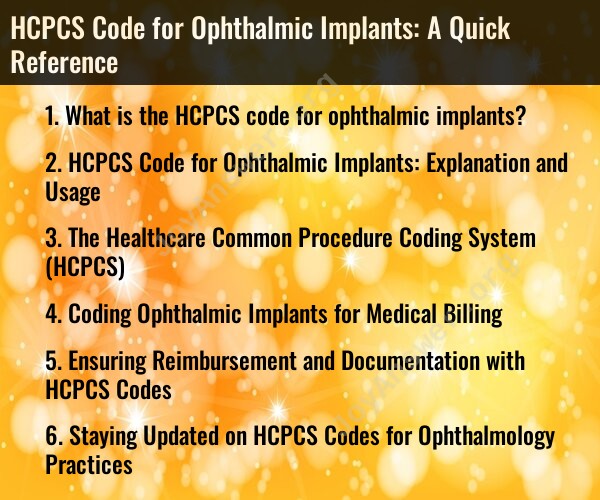What is the HCPCS code for ophthalmic implants?
Healthcare Common Procedure Coding System (HCPCS) codes are used to describe and report medical procedures, services, and supplies, including various medical devices and implants. When it comes to ophthalmic implants, the specific HCPCS code used can vary depending on the type of implant or device. Some common HCPCS codes for ophthalmic implants and devices include:
HCPCS Code C1782: Intraocular lens (IOL), cataract surgery, one-piece, PMMA.
HCPCS Code C1783: Intraocular lens (IOL), cataract surgery, one-piece, acrylic.
HCPCS Code C1784: Intraocular lens (IOL), cataract surgery, one-piece, other material.
HCPCS Code C1785: Intraocular lens (IOL), cataract surgery, three-piece, PMMA.
HCPCS Code C1786: Intraocular lens (IOL), cataract surgery, three-piece, acrylic.
HCPCS Code C1787: Intraocular lens (IOL), cataract surgery, three-piece, other material.
These are just a few examples of HCPCS codes for ophthalmic implants. The specific code used can vary depending on factors such as the type of implant, the material used, and the manufacturer. Healthcare providers, hospitals, and billing professionals use these codes to report the use of ophthalmic implants for reimbursement and tracking purposes. It's important to consult with the latest HCPCS coding resources and guidelines to ensure accurate and up-to-date coding for specific ophthalmic implants.
HCPCS Code for Ophthalmic Implants: Explanation and Usage
HCPCS, or Healthcare Common Procedure Coding System, is a standardized coding system used to report medical services and procedures to healthcare payers. HCPCS codes are used by physicians, hospitals, and other healthcare providers to bill for services and receive reimbursement.
Ophthalmic implants are medical devices that are surgically inserted into the eye to treat a variety of conditions, such as glaucoma, cataracts, and retinal detachment. There are a variety of different ophthalmic implants available, each with its own unique HCPCS code.
Some common HCPCS codes for ophthalmic implants include:
- L8610: Ocular implant
- L8611: Intraocular lens implant
- L8612: Aqueous drainage implant
- L8613: Vitreous body implant
- L8615: Retinal implant
The Healthcare Common Procedure Coding System (HCPCS)
The HCPCS code set is divided into two levels:
- Level I codes are national codes that are maintained by the Centers for Medicare & Medicaid Services (CMS).
- Level II codes are add-on codes that are developed and maintained by private insurance companies and other payers.
Level II codes are used to report services and procedures that are not included in the Level I code set.
Coding Ophthalmic Implants for Medical Billing
When coding ophthalmic implants for medical billing, it is important to use the correct HCPCS code for the specific implant that is used. The HCPCS code should also be reported with any applicable modifiers.
For example, if an intraocular lens implant is used during cataract surgery, the HCPCS code L8611 would be reported. If the implant is a multifocal lens, the modifier LT would be appended to the HCPCS code.
Ensuring Reimbursement and Documentation with HCPCS Codes
To ensure reimbursement for ophthalmic implants, it is important to submit accurate and complete claims to healthcare payers. Claims should include the correct HCPCS codes, modifiers, and documentation.
Documentation should include a detailed description of the implant that was used, as well as the reason why the implant was necessary.
Staying Updated on HCPCS Codes for Ophthalmology Practices
HCPCS codes are updated on a regular basis. It is important for ophthalmology practices to stay updated on the latest HCPCS codes to ensure that they are billing for services and procedures accurately.
Practices can stay updated on HCPCS codes by visiting the CMS website or by subscribing to HCPCS coding updates from a private payer.
Conclusion
HCPCS codes are an important part of medical billing for ophthalmic implants. By using the correct HCPCS codes and providing accurate documentation, ophthalmology practices can ensure reimbursement for their services.













